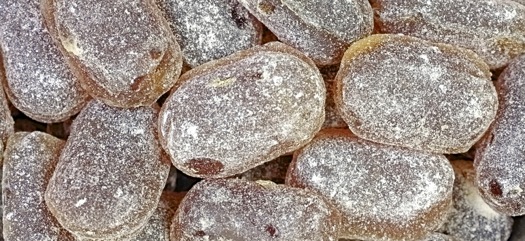Syrup Good, Crystal Bad

Reader Marta asks, since I mentioned “crystalline candy” below, if there’s such a thing as “non-crystalline” candy. Indeed there is, Marta. In fact most candy is non-crystalline. “Amorphous” is another term for this sort of candy, since it lacks a crystal structure (amorphous is Greek for “without shape”). Ultra-dense syrups are what they are. Sometimes they go by the name of “non-grained” candies. The family includes virtually every hard candy you’ve ever seen: butterscotch drops, sour balls and the like, also peanut brittles and gumdrops.
In the post below on how fondants work, I mentioned that crystalline candies begin as supersaturated solutions of boiling water and sugar. The same is true of non-crystalline candies, except that in their case, the solutions are not allowed to crystallize. The neat thing about supersaturated sugar solutions is that as long as you don’t disturb them they’re capable of cooling all the way down without crystallizing, turning into a hard, clear mass (clear because without any crystals or air bubbles inside, light rays pass straight through instead of scattering).
In truth, however, that doesn’t happen very often, as the slightest bump — even a stiff breeze — is enough to create a nucleation point for a single, tiny crystal. That first crystal forms, and a runaway mass-crystallization begins. A few moments later the whole batch is a cloudy, crunchy rock. Don’t let it happen in your food processor.
Candy makers avoid unwanted random crystallizations like this by introducing so-called “interfering agents” into their syrups to act as a buffer against crystal formation. It’s a fancy term for just about any substance you can add that will get between the tiny sucrose LEGOs to keep them from stacking up on each other. Glucose and fructose molecules are very good at the job, and both are found in abundance in honey and corn syrup (which can simply be added) or in invert syrup (which can be created by adding acid). Other interfering agents include long-chain starches (also found in corn syrup) and fats.
Depending on the candy being made, the use of interfering agents can be heavy. Some types of candies require more corn syrup than sugar in order to maintain the required texture. Probably more than you needed to know, Marta, but I’ve had a lot of tea this morning!